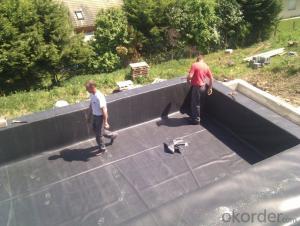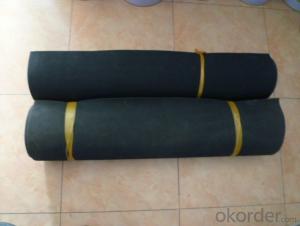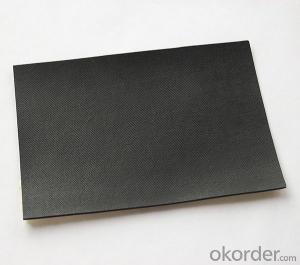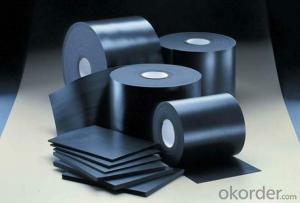EPDM Waterproof Membrane with 1.0mm for Basement Project
- Loading Port:
- Shanghai
- Payment Terms:
- TT OR LC
- Min Order Qty:
- 20000 m²
- Supply Capability:
- 5000000 m²/month
OKorder Service Pledge
OKorder Financial Service
You Might Also Like
EPDM Waterproof Membrane with 1.0mm for Basement Project
Description Of EPDM Waterproof Membrane with 1.0mm for Basement Project:
1. EPDM waterproof membrane is made from ternary ethylene-propylene rubber, which is for waterproofing of exposed and non-exposed applications.
2. EPDM waterproof membrane production adopts the world-advanced equipment of cold feeding extrusion and continuous vulcanization technology.
3. EPDM waterproof membrane is of high elasticity among high polymer waterproof materials and becomes a world-popular waterproofing material.
Main Features of EPDM Waterproof Membrane with 1.0mm for Basement Project:
1.Excellent anti aging performance ,service life up to 50 years.
2.High extension rate,high tensile strength ,small size changes at heat treatment.
3.Good plant roots penetrability resistance and can be made waterproofing layer of planting roof.
4.Special modified molecular structure ,effectively resolving the current domestic and foreign glue joint problem.
5.Good low temperature flexibility ,and good performance of adapting to ambient temperature changes.
6.Convenient application ,solid joint ,no environment pollution.
7.Chemical corrosion resistance ,can be used for special occasions.
8.Good anti-perforated.
Specifications of EPDM Waterproof Membrane with 1.0mm for Basement Project:
| Material | EPDM Rubber |
| Size | 1.2m (width)*20m (length) or customized, weldable type 2.05m or 4m width |
| Thick | 1.2mm, 1.5mm, 2.0mm |
| Type | Vulcanized & Weldable |
| Pattern | Non-reinforced (homogeneous) |
| Certificate | ISO9001/14001 |
Applications of EPDM Waterproof Membrane with 1.0mm for Basement Project:
1. Roofs, Basement, Toilet
2. Industrial and civil building waterproofing
3. Geo-synthetic liner for swimming pool, channels, irrigation system
4. Especially suit for projects with high requirements in durability, anti-corrosion and deformation

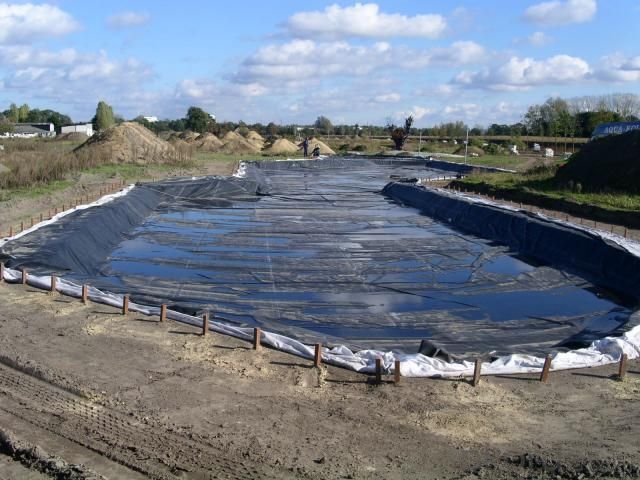

IMages of EPDM Waterproof Membrane with 1.0mm for Basement Project:




FAQ of EPDM Waterproof Membrane with 1.0mm for Basement Project:
1. What are we supplying?
We are specialized in producing Colorful Asphalt Roof Shingle, SBS/APP modified bitumen waterproof membrane, Self adhesive bitumen waterproof membrane, PVC waterproofing membrane, EPDM rubber roofing membrane, Single Component Polyurethane Waterproof Coating, and Spray Polyurea Waterproof Coating
.
2. How Many years experience do we have?
We have been exported to more than 20 countries in the past 15 years.
3. How long do we usually reply your request?
We always reply our customer within 24 hours.
- Q:Can a waterproofing membrane be used for shopping malls or commercial buildings?
- Yes, a waterproofing membrane can be used for shopping malls or commercial buildings. Waterproofing membranes are commonly used in construction to provide a protective barrier against water infiltration, which is crucial for the longevity and maintenance of buildings. They are particularly effective in areas prone to heavy rainfall or where water exposure is a concern, making them suitable for shopping malls and commercial buildings where water damage can be costly and disruptive.
- Q:Can a waterproofing membrane be used for tunnels or underground structures?
- Yes, a waterproofing membrane can be used for tunnels or underground structures. Waterproofing membranes are specifically designed to prevent the ingress of water and protect structures from moisture damage. Tunnels and underground structures are often exposed to groundwater or high levels of moisture, making waterproofing essential to maintain their integrity and durability. The waterproofing membrane is applied to the exterior surface of the tunnel or underground structure, creating a barrier that prevents water penetration. It acts as a protective layer, preventing water from seeping through the walls, roof, or floor. There are various types of waterproofing membranes available, including bituminous, polyurethane, and cementitious membranes. Each type offers different properties and advantages depending on the specific requirements of the project. In addition to preventing water infiltration, waterproofing membranes also provide protection against other potential issues such as corrosion, mold growth, and structural damage. They help to extend the lifespan of the tunnel or underground structure and reduce maintenance and repair costs. It is important to ensure that the waterproofing membrane is properly installed by qualified professionals to ensure its effectiveness. Regular inspections and maintenance are also crucial to identify any potential issues and address them promptly. Overall, a waterproofing membrane is a highly effective solution for tunnels and underground structures, providing long-lasting protection against water damage and ensuring their structural integrity.
- Q:Can a waterproofing membrane be used in hospitals or healthcare facilities?
- Waterproofing membranes have the ability to be utilized in hospitals and healthcare facilities. In reality, it is highly advisable to employ waterproofing membranes in these settings as it is crucial to maintain a clean and hygienic environment. Typically, waterproofing membranes are applied on floors, walls, and ceilings to prohibit the infiltration of water or moisture. This infiltration can result in the growth of mold, the deterioration of building materials, and the compromise of the facility's structural integrity. By utilizing waterproofing membranes, healthcare facilities can effectively shield against water damage, facilitate easier cleaning and maintenance, and prevent the growth of harmful microorganisms and bacteria. Furthermore, waterproofing membranes can also assist in managing moisture levels, thereby reducing the risk of slips and falls. This reduction in risk is particularly vital in areas frequently visited by patients, staff, and visitors. Overall, waterproofing membranes are an invaluable asset in ensuring the safety, durability, and cleanliness of hospitals and healthcare facilities.
- Q:Are waterproofing membranes suitable for stadium structures?
- Waterproofing membranes are well-suited for stadium structures. Stadiums are exposed to different weather conditions, such as rain, snow, and humidity, which can potentially harm the structure if proper waterproofing measures are not taken. By providing a protective layer that prevents water infiltration, waterproofing membranes safeguard the stadium from moisture-related problems like leaks, mold, and corrosion. Water accumulation on large roof areas and expansive seating areas is common in stadium structures, making waterproofing essential. Membranes can be applied on various surfaces, such as concrete, metal, and wood, offering a versatile and effective waterproofing solution for stadiums. Furthermore, waterproofing membranes offer durability and longevity, which is crucial for stadiums that experience heavy usage and constant exposure to the elements. They are designed to withstand thermal expansion and contraction, as well as UV radiation, ensuring long-term protection for the structure. Moreover, architects and engineers can customize waterproofing membranes to meet specific design requirements, seamlessly integrating them into the stadium's overall aesthetic. These membranes come in various colors, textures, and finishes, allowing them to blend with the surrounding materials and enhance the stadium's visual appeal. In conclusion, waterproofing membranes are a reliable and effective solution for protecting stadium structures from water damage. They provide durability, versatility, and customization options, making them suitable for any stadium construction or renovation project.
- Q:Can a waterproofing membrane be used for bridge or tunnel waterproofing?
- Yes, a waterproofing membrane can be used for bridge or tunnel waterproofing. Waterproofing membranes are commonly used in construction projects to prevent water penetration and protect structures from potential damage caused by moisture. In the case of bridges and tunnels, which are exposed to harsh environmental conditions and high water pressure, a high-quality waterproofing membrane can effectively provide an impermeable barrier, ensuring the long-term durability and structural integrity of these infrastructure elements.
- Q:How does a waterproofing membrane work?
- A waterproofing membrane works by creating a physical barrier that prevents water from penetrating through a surface. It is typically made of a durable material, such as rubber or synthetic polymers, that is applied to the surface to be protected. This membrane forms a seamless and impermeable layer, effectively preventing water from seeping into the underlying structure. Additionally, some membranes also have the ability to expand and contract with temperature changes or movement, ensuring long-term protection against water damage.
- Q:Can a waterproofing membrane be used for pond or pool applications?
- Yes, a waterproofing membrane can be used for pond or pool applications. Waterproofing membranes are designed to provide a barrier against water penetration, making them an ideal choice for sealing ponds and pools. These membranes are typically made from synthetic materials such as PVC, EPDM, or TPO, which are highly resistant to water and UV rays. They are available in various thicknesses and can be customized to fit the specific dimensions of the pond or pool. Additionally, waterproofing membranes are durable and flexible, allowing them to withstand the constant exposure to water and the movement of the underlying substrate. Overall, using a waterproofing membrane for pond or pool applications can help prevent leaks, prolong the lifespan of the structure, and ensure a safe and enjoyable water environment.
- Q:Can a waterproofing membrane be used on flat roofs?
- Yes, a waterproofing membrane can be used on flat roofs. In fact, it is one of the most common and effective methods of waterproofing flat roofs. A waterproofing membrane is a thin layer of material that is applied to the surface of the roof to prevent water from penetrating through. It is typically made of a durable and flexible material, such as synthetic rubber or modified bitumen, which can withstand the elements and provide long-lasting protection. The membrane is installed in overlapping layers, creating a continuous barrier that effectively seals the roof and prevents water from leaking into the building. Additionally, waterproofing membranes can also provide insulation and energy efficiency benefits, making them a popular choice for flat roof applications.
- Q:Can waterproofing membranes be used on outdoor decks?
- Outdoor decks can indeed benefit from the use of waterproofing membranes. These membranes are highly favored among deck owners due to their ability to effectively block moisture, thus safeguarding the underlying structure from harm. Comprised of durable materials like rubber or PVC, these membranes are specifically crafted to endure exposure to the elements. They are directly applied onto the deck surface, effectively establishing a watertight seal that serves as a protective shield against rain, snow, and other forms of moisture. Moreover, by preventing water damage, rot, and decay, waterproofing membranes contribute significantly to extending the lifespan of the deck. Consequently, incorporating waterproofing membranes into the maintenance routine of outdoor decks proves to be not only a sensible approach but also an efficient one, ensuring the deck's structural integrity and longevity are well-preserved.
- Q:Can a waterproofing membrane be used for museums or art galleries?
- Yes, a waterproofing membrane can be used for museums or art galleries. It plays a crucial role in protecting valuable artwork and artifacts from moisture damage, mold, and other environmental factors. By creating a barrier against water penetration, a waterproofing membrane helps to maintain the integrity and longevity of the exhibits, ensuring their preservation and preventing any potential harm caused by moisture.
1. Manufacturer Overview |
|
|---|---|
| Location | |
| Year Established | |
| Annual Output Value | |
| Main Markets | |
| Company Certifications | |
2. Manufacturer Certificates |
|
|---|---|
| a) Certification Name | |
| Range | |
| Reference | |
| Validity Period | |
3. Manufacturer Capability |
|
|---|---|
| a)Trade Capacity | |
| Nearest Port | |
| Export Percentage | |
| No.of Employees in Trade Department | |
| Language Spoken: | |
| b)Factory Information | |
| Factory Size: | |
| No. of Production Lines | |
| Contract Manufacturing | |
| Product Price Range | |
Send your message to us
EPDM Waterproof Membrane with 1.0mm for Basement Project
- Loading Port:
- Shanghai
- Payment Terms:
- TT OR LC
- Min Order Qty:
- 20000 m²
- Supply Capability:
- 5000000 m²/month
OKorder Service Pledge
OKorder Financial Service
Similar products
New products
Hot products
Hot Searches
Related keywords
